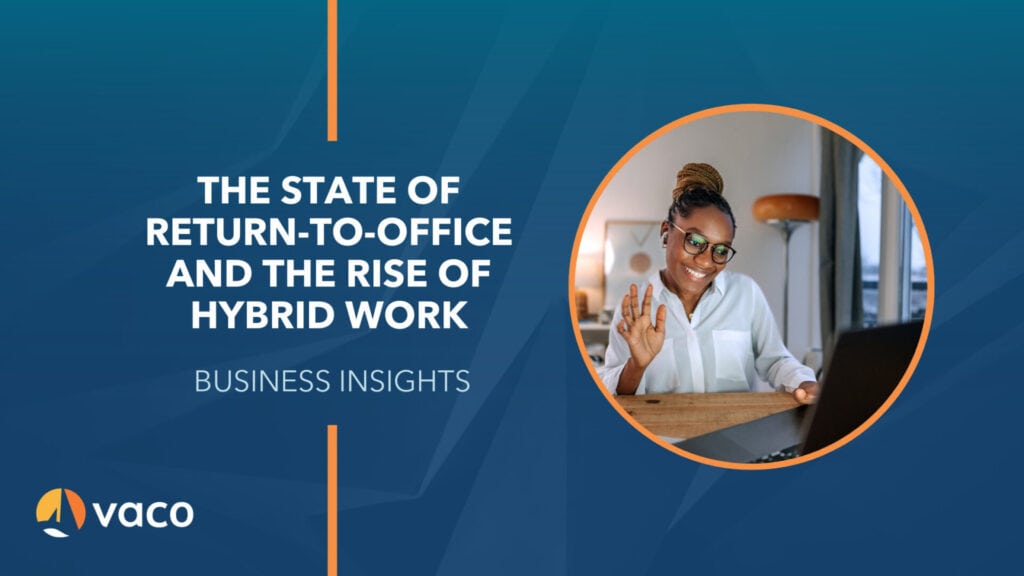While employers are still offering remote-work flexibility, there’s a shift among major organizations to call people back to the office in one form or another. What does that arrangement look like, how do employees feel about it, and where are we headed with future work arrangements?
Remember when remote work was a risky proposition? In 2020, nine million employees successfully worked from home full-time during the pandemic, a time referred to as the great work-from-home experiment. Despite concerns, a Stanford study showed that productivity actually increased 13% for remote workers. The practice took off, and just two years later, the number of remote workers tripled to 27.6 million, according to the U.S. Census Bureau.
But now the pendulum is starting to swing back.
Many employers are asking or even mandating that workers come back to the office in some capacity for purposes like culture, training, alignment and collaboration. In 2021, 42% of organizations had embraced hybrid work arrangements, and that number is expected to grow to 81% by 2024, according to an AT&T study.
IN THIS BLOG:
Vaco works with both job seekers and hiring organizations, and we’re finding that the return to the office is a recurring conversation brought up by both sides. While employers are eager to get workers back to the office, there is a strong employee resistance to returning full time. A hybrid approach seems to be the prevailing choice, but every organization is making decisions about returning to the office based on their unique needs.
In this article, we’ll touch on what we’re seeing and offer a perspective about why trends are playing out this way; we’ll also cover the different types of work arrangements organizations are implementing and share some advice to help both employers and employees navigate the new norm.
What is hybrid remote work?
Generally speaking, hybrid work describes the flexibility given to employees to split their time between working from home (or anywhere) and going into the office. The definition is purposely vague, since there is no centralized model of what hybrid work looks like, and each organization defines hybrid work in their own way.
This year, we are seeing a mix of hybrid options; from working 2-3 days per week in the office (this is the most common), to working one week out of the month from the office – this, of course, is to accommodate those employees who live too far to commute in on a more regular basis. Working arrangements vary, and they are completely customizable based on the needs of the employer and the employee.
What we’re seeing on the employee side
Over the past two years, remote and hybrid positions have dominated job postings, reshaping workplace norms and giving employees and job seekers leverage when it comes to flexibility and where they work. The labor market is tight, meaning there are more open jobs than there are workers to fill them, and employers remain open to offering flexible working arrangements.
According to a June 2022 Gallup Workplace survey of employees:
- Over 90% of remote workers do not want to return to full-time, onsite work
- 65% of workers prefer hybrid work, and
- Only 6% of workers want to work in the office full-time
A Slack survey showed similarly lower interest in full-time onsite work from the employee standpoint, reporting that only 12% of the respondents would choose to be in the office full-time.
In a report shared by Webex, if full-time, in-office work is mandated, 57% of employees said they would consider leaving their organization.
Remote workers will tell you that the benefits of telecommuting include higher productivity, no commute, better work-life balance, flexibility with in-home childcare, greater workplace diversity and the ability to save more money. There are tangible perks to working from home, and employees don’t want to give them up.
Those who enjoy working hybrid schedules often feel like they get the best of both worlds. They still have the flexibility to work from home as needed, but they can also build relationships, get face time with managers and peers, and collaborate in person again.
What we’re seeing on the employer side
Despite initially providing 100% remote work-from-home arrangements at the start of 2020, many employers who previously embraced remote work have been reconsidering their stance. In early 2022, 50% of business leaders indicated they had plans in place to bring the workforce back to the office full-time. Those plans met resistance from remote employees, some of whom protested or ignored the polices in defiance. In an effort to retain workers, many organizations dialed back their strict return-to-office approach in favor of a more flexible, hybrid alternative.
But, as 2022 went on and COVID-19 fears began to decrease, employers started developing new policies and plans for returning to the office. In the second half of 2022, 90% of business leaders surveyed said they would require employees to return to the office in a hybrid capacity.
Now that 2023 is in full swing, we have observed firmer return-to-office policies:
- Many organizations have become stricter on return-to-office mandates, and the proportion of roles specifying they are onsite has risen to a 19-month high of 4.2%.
- The percentage of opportunities characterized as remote has slipped to a 10-month low of 13.8%.
- The hybrid model with work-from-home flexibility has become the most common, with roughly 60%-65% of organizations offering the ability to work remotely in some capacity.
- Some enterprise organizations that previously attracted talent through remote work are switching or have switched to hybrid arrangements. These include employers like Amazon, Disney, General Motors, UPS, Microsoft and Apple, although their definitions of “hybrid” differ.
The factors driving the shift away from remote work include employers’ desire to build culture, increase productivity, encourage collaboration and train new staff. Organizations say that junior employees tend to onboard more quickly and expand their skill sets when working alongside senior-level, more experienced colleagues onsite.
Still, with fears of losing valued workers amidst an ongoing labor shortage, 88% of companies are trying to incentivize employees to work onsite with perks like meals or reimbursements for parking and travel.
What the call back to the office looks like
There is no one-size-fits-all when it comes to returning to the office, and many companies are exploring their options. The major return-to-office models are:
- Flexible hybrid work. Employees have the freedom to choose when and where to work. They can work remotely or go into the office, selecting on a daily basis whatever works best for their situation and current workload. Organizations that leverage this model can cast a wider net and attract more diverse talent. But beware: workers often report traveling into the office only to find that no one else is there; and, aligning schedules for onsite team meetings is more difficult when nothing is mandatory.
- Remote-first hybrid work. Employees have the flexibility to work remotely as much as they want but are occasionally asked to go to the office for meetings, functions or planned collaboration. As with flexible hybrid work, organizations with such policies have access to a wider range of talent, and workers have most of the benefits of remote work. This scenario tends to ensure that employees are together for key interactions. Holding smaller, onsite team meetings is usually dictated by the manager. Often, the employee will travel to the office for a specific event during the workday and leave soon after. Time spent onsite is very deliberate.
- Office-first hybrid work. Employees are asked to be in the office on certain days and can work from home on the other days. Organizations whose work requires in-person collaboration tend to go this route, and employees still have the flexibility of remote work. Some organizations mandate the days on which employees must go to the office; others leave it up to individual managers. The number of days the employee must be onsite varies from one to four days per week.
- Back to the office full-time. No exceptions. A minority of large organizations have mandated employees return to the office full-time and said those who don’t comply will be terminated.
Organizations each have their own version of these models, and they even vary according to the seniority level of the employee and the distance they live from the office. Managers might be flown to the office quarterly or monthly for a few days, while lower-level employees living farther away might need to travel to the office only a couple times a year.
Final advice on returning to the office
The future of work predominantly seems to be a model that merges remote work with being onsite. There are many routes organizations can take when asking employees to return to the office. Choosing the right strategy requires a delicate balance since remaining flexible benefits companies that want to continue to attract workers in a challenging labor market.
For organizations that weren’t originally fully remote pre-2020, continuing to offer this arrangement opens up the talent pool, increases productivity and lowers costs by foregoing office spaces owned or leased, removing costs of in-office equipment and supplies and drastically reducing travel expenses incurred by employees. It’s best for organizations seeking new talent to practice transparency when navigating this evolving landscape. Employees should ask questions about work arrangements up front and potentially negotiate terms.
The world of work continues to evolve, as it always will; and hybrid work is the prevailing theme as 2023 progresses.
ABOUT OUR AUTHOR

Eric Holler is an associate director of accounting and finance talent solutions at Vaco in Indianapolis.
